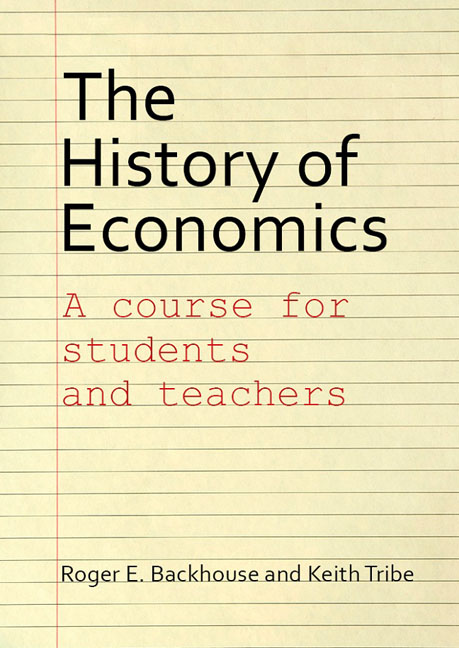Book contents
- Frontmatter
- Contents
- Introduction
- Lecture 1 Commerce, Wealth and Power: The Disputed Foundations of the Strength of a Nation
- Lecture 2 Natural Order, Physiocracy and Reform
- Lecture 3 Adam Smith I: Outline of a Project
- Lecture 4 Adam Smith II: The Two Texts
- Lecture 5 The Political Economy of Malthus and Ricardo
- Lecture 6 Political Economy in Continental Europe and the United States
- Lecture 7 Political Economy, Philosophic Radicalism and John Stuart Mill
- Lecture 8 Popular Political Economy: List, Carey, Bastiat and George
- Lecture 9 Radical Political Economy: Marx and His Sources
- Lecture 10 Marginalism and Subjectivism: Jevons and Edgeworth
- Lecture 11 From Political Economy to Economics
- Lecture 12 Alfred Marshall’s Project
- Lecture 13 Markets and Welfare after Marshall
- Lecture 14 Monetary Economics
- Lecture 15 The Rise of Mathematical Economics
- Lecture 16 Robbins’s Essay and the Definition of Economics
- Lecture 17 John Maynard Keynes
- Lecture 18 Quantitative Economics
- Lecture 19 The Keynesian Revolution
- Lecture 20 Modern Macroeconomics
- Lecture 21 Inflation and the Phillips Curve
- Lecture 22 Popular Economics
- Lecture 23 Economics and Policy
- Lecture 24 Ideology and Place
- Index
Lecture 3 - Adam Smith I: Outline of a Project
Published online by Cambridge University Press: 09 August 2023
- Frontmatter
- Contents
- Introduction
- Lecture 1 Commerce, Wealth and Power: The Disputed Foundations of the Strength of a Nation
- Lecture 2 Natural Order, Physiocracy and Reform
- Lecture 3 Adam Smith I: Outline of a Project
- Lecture 4 Adam Smith II: The Two Texts
- Lecture 5 The Political Economy of Malthus and Ricardo
- Lecture 6 Political Economy in Continental Europe and the United States
- Lecture 7 Political Economy, Philosophic Radicalism and John Stuart Mill
- Lecture 8 Popular Political Economy: List, Carey, Bastiat and George
- Lecture 9 Radical Political Economy: Marx and His Sources
- Lecture 10 Marginalism and Subjectivism: Jevons and Edgeworth
- Lecture 11 From Political Economy to Economics
- Lecture 12 Alfred Marshall’s Project
- Lecture 13 Markets and Welfare after Marshall
- Lecture 14 Monetary Economics
- Lecture 15 The Rise of Mathematical Economics
- Lecture 16 Robbins’s Essay and the Definition of Economics
- Lecture 17 John Maynard Keynes
- Lecture 18 Quantitative Economics
- Lecture 19 The Keynesian Revolution
- Lecture 20 Modern Macroeconomics
- Lecture 21 Inflation and the Phillips Curve
- Lecture 22 Popular Economics
- Lecture 23 Economics and Policy
- Lecture 24 Ideology and Place
- Index
Summary
Aims of the lecture
1. To provide an outline biography of Adam Smith and the development of his work.
2. To show how biography helps us also understand the context for his writings.
3. To outline the reception of these writings, and the various approaches taken to them by modern commentary.
Bibliography
The standard edition of all Adam Smith’s writings and correspondence is the Glasgow edition published by Oxford University Press from 1976 onwards; this is also available in a cheap but well-produced paperback from Liberty Press. Unfortunately, no electronic version of this edition is currently available: this was taken down from the Library of Liberty site in February 2014 and replaced with a digitized version of the 1904 Cannan edition of Wealth of Nations, and there is no ebook version of the Glasgow edition. While Cannan’s edition has been superseded by the Glasgow edition, it does remain usable; since the Liberty Press paperback version is so cheap, however, there is no reason to refer to any of the many other editions of Wealth of Nations that are available. The Glasgow edition numbers paragraphs, and so the standard form of reference is not by page but generally as [Work] [Book].[Chapter].[Paragraph], e.g. WN IV.ix.3.
The Glasgow edition is in six volumes, each referred to below by initials as follows.
I. The Theory of Moral Sentiments (1759, based on the sixth edition of 1790) [TMS].
II. An Inquiry into the Nature and Causes of the Wealth of Nations (1776, based on the third edition of 1784) [WN].
III. Essays on Philosophical Subjects (1795) [EPS].
IV. Lectures on Rhetoric and Belles Lettres (first published 1963) [LRBL].
V. Lectures on Jurisprudence (first part-published 1896) [LJ].
VI. Correspondence of Adam Smith (1977) [Correspondence].
Adam Smith was a reluctant correspondent, and almost all his papers were destroyed on his instruction after his death; the principal source for most of what we know of his life and teaching is Dugald Stewart’s “Account of the Life and Writings of Adam Smith, L.L.D.” (EPS: 263–351). All subsequent biographies have built upon this in one way or another. The most accessible of these is Nicholas Phillipson’s Adam Smith: An Enlightened Life (London: Penguin, 2011).
- Type
- Chapter
- Information
- The History of EconomicsA Course for Students and Teachers, pp. 33 - 48Publisher: Agenda PublishingPrint publication year: 2017



